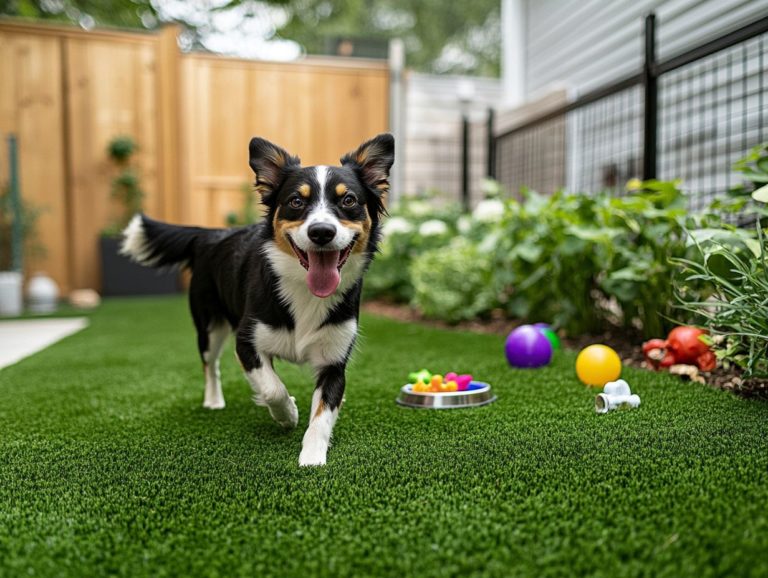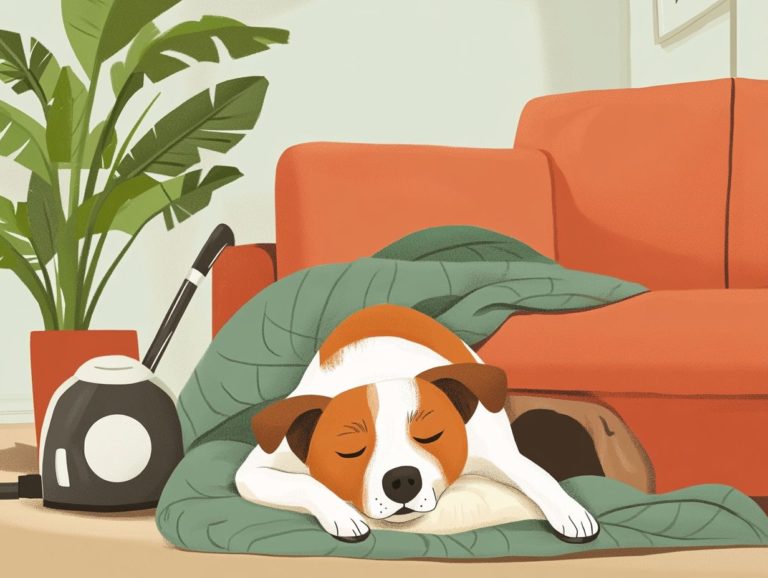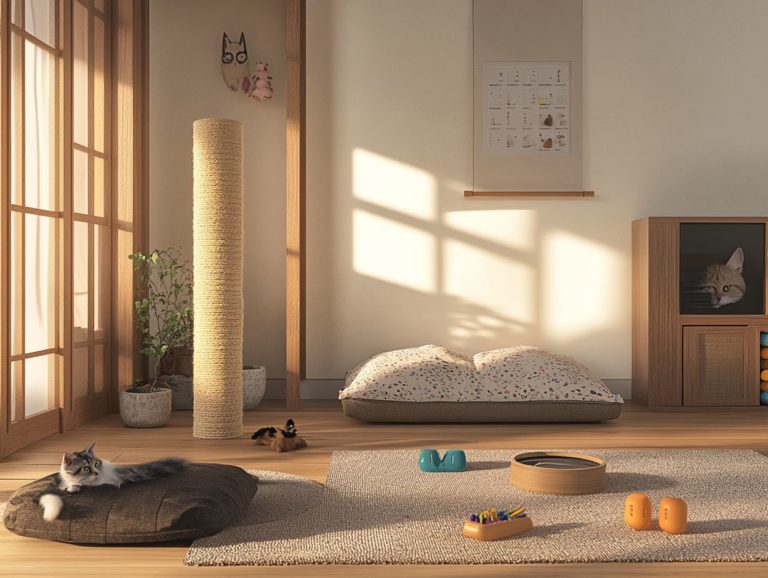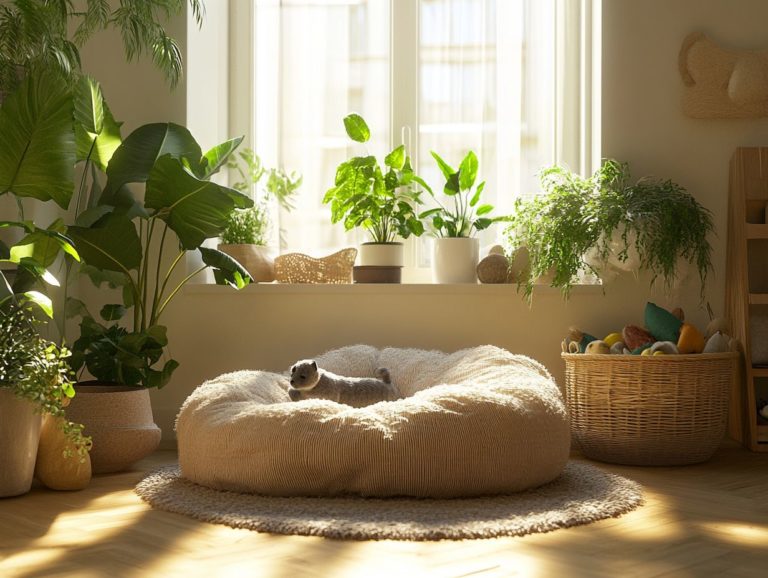Using White Noise to Sooth Anxious Pets
Pet anxiety is becoming an increasingly pressing issue for many pet owners. It can manifest in various distressing behaviors for both pets and their families.
Understanding the causes of pet anxiety is crucial. This includes issues like separation anxiety and noise-induced anxiety. Recognizing these can lead to effective solutions.
One widely adopted method to soothe anxious pets is white noise, especially through the use of a white noise machine. This can create a calming environment for your furry friend.
This article delves into the benefits of white noise, highlights the types of sounds, including pink noise, that are most effective, and offers practical tips for incorporating it into your pet’s daily routine. It will also explore alternative calming techniques.
Transform your pet’s anxiety into calm! Discover how white noise can help during stressful times like fireworks.
Contents
- Key Takeaways:
- Understanding Pet Anxiety
- Benefits of White Noise for Pets
- Types of White Noise for Pets
- Using White Noise to Create a Safe Space
- Tips for Using White Noise with Pets
- Best Practices and Precautions
- Alternatives to White Noise for Pet Anxiety
- Frequently Asked Questions
- How does white noise help to soothe anxious pets?
- What types of pets can benefit from white noise?
- How loud should the white noise be for it to be effective?
- Can white noise be used for pets with separation anxiety?
- Is white noise safe for pets to listen to for extended periods of time?
- Are there any potential downsides to using white noise for anxious pets?
Key Takeaways:
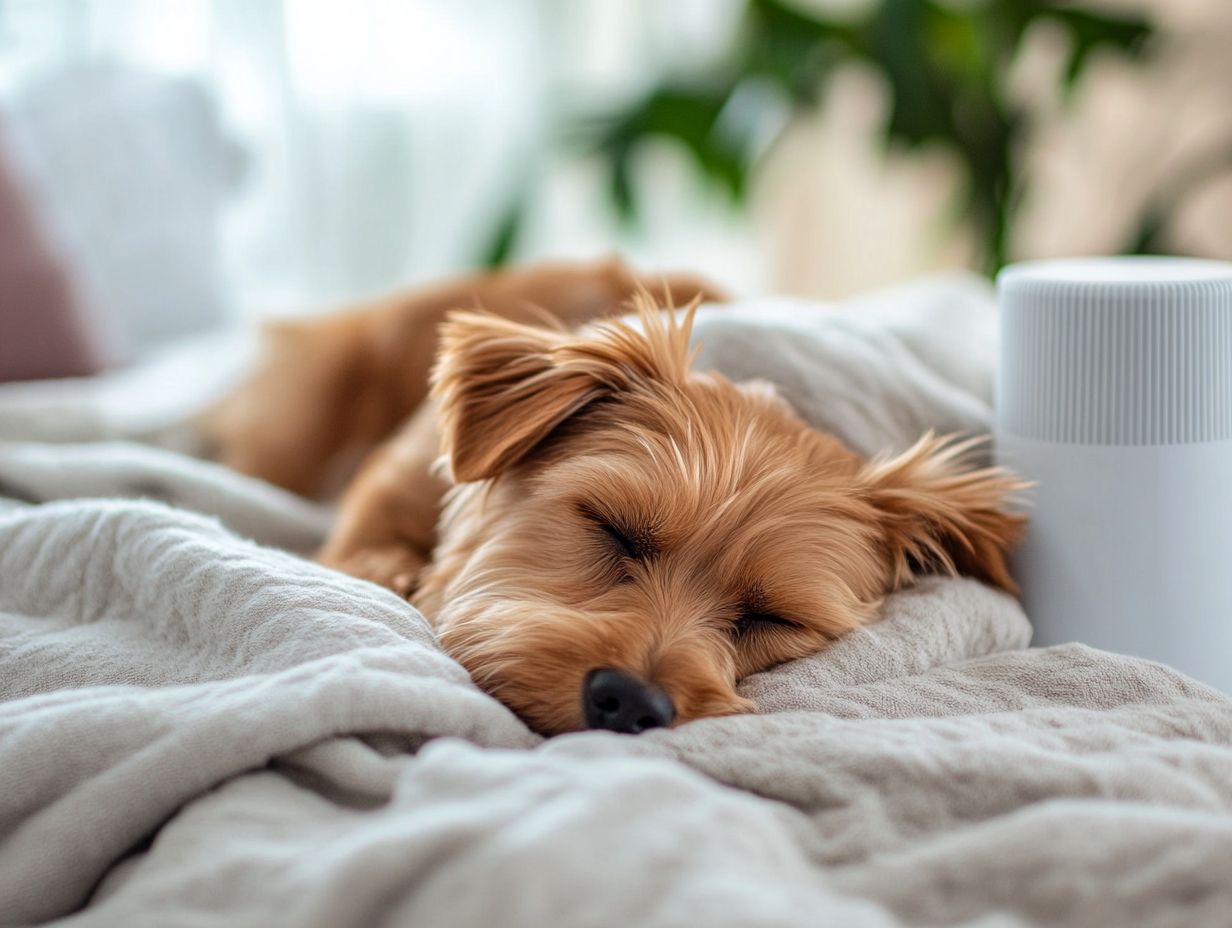
- White noise can help soothe anxious pets by providing a calming background sound that masks sudden noises.
- Creating a safe and comforting environment can reduce your pet’s stress and anxiety.
- When using white noise, choose the right type of sound for the best results. Think about other ways to calm your pet as well.
Understanding Pet Anxiety
Understanding dog anxiety is essential for you as a pet owner. Factors such as separation anxiety, noise phobias, and other triggers can deeply affect your dog’s behavior. This often leads to increased stress hormone levels and restlessness.
By recognizing these challenges, you can implement effective anxiety management strategies, such as sound conditioning. These methods enhance your pet’s well-being and strengthen your bond. Veterinarians often point out that pets can be more anxious if they are sensitive to sounds, making it crucial to address these issues for your beloved companion.
Causes and Symptoms
Pet anxiety can arise from various sources, including separation anxiety and shifts in routine. Dogs may display notable symptoms, particularly during events like fireworks displays or thunderstorms.
Many restless dogs experience heightened anxiety during these events, reacting to loud noises with fear. You might notice signs like excessive barking or destructive chewing on furniture, both indicating anxiety.
Changes in appetite can also be a clear indicator of anxiety. Stressed dogs often eat less or may refuse food entirely. Recognizing these symptoms is essential for effective stress relief strategies. Create a safe haven with comforting items or consult a veterinarian for behavioral modifications, especially in cases of dog anxiety.
Benefits of White Noise for Pets
Using white noise, especially from devices like the Snooz Original, can help your pet feel calm. This simple addition creates a serene atmosphere, helping your furry friend feel more at ease and secure during stressful events.
How White Noise Can Help Calm Anxious Pets
White noise is an effective ally in calming anxious pets. It creates a soothing atmosphere that minimizes their reaction to sudden sounds.
This works by lowering their sensitivity to sounds and using sound exposure therapy. This helps dogs feel more secure in their environment.
Sound masking techniques use background noise to cover startling noises. These techniques can dramatically ease a dog s anxiety, especially during loud events.
Incorporating calming music and soothing sounds from products like the Dohm Classic or Pawzz is also vital. Specific frequencies and rhythms promote relaxation.
These strategies ease fear and create comfort. They transform a dog’s living space into a tranquil haven, which is essential for effective training.
Types of White Noise for Pets
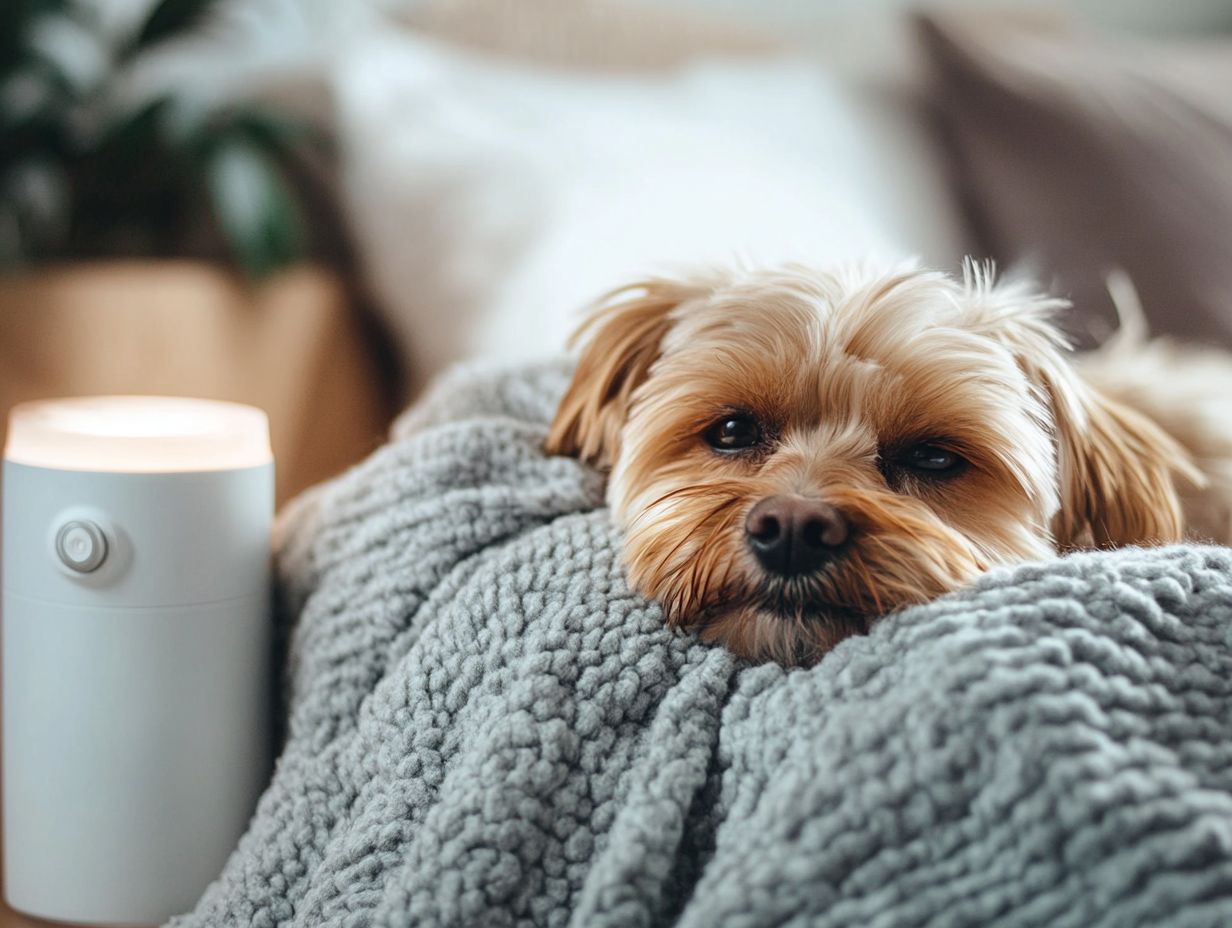
You have several white noise options to soothe your anxious pets. These include pink noise and brown noise, each with unique sound properties.
Whether it s the balanced hum of white noise, the softer tones of pink noise, or the deeper resonance of brown noise, you can create a calming environment that enhances their stress relief.
Different Sounds and Their Effects
Different sounds can influence your pets uniquely. Certain frequencies and tones, including relaxing sounds from sound machines, can offer greater anxiety relief.
For example, calming music with gentle melodies can soothe a skittish dog during thunderstorms. It acts as an auditory blanket against stress.
Nature sounds, like the soft patter of rain or the rustle of leaves, evoke peace and safety for your furry friend. This contributes to their overall well-being.
White noise machines, like those from Google LLC, provide consistent sounds that mask unsettling noises. This promotes relaxation even further.
Understanding how different sound stimuli influence behavior is crucial. It allows you to create a calm sanctuary for your beloved animals.
Using White Noise to Create a Safe Space
Using white noise effectively transforms your pet’s environment into a sanctuary. This significantly alleviates their anxiety during stressful events like thunderstorms and fireworks.
By creating a calming backdrop, you provide your furry friend with the comfort they need to feel secure and relaxed.
Creating a Calming Environment for Your Pet
Start creating a calming environment by incorporating soothing solutions. Consider white noise machines and other comforting sounds to help ease anxiety.
In addition to these auditory elements, play calming music. Research shows it can help dogs relax and reduce their stress levels.
Establish a familiar space, perhaps a cozy corner with their favorite blanket and toys. This enhances their sense of security during stressful situations.
By integrating sound exposure therapy and auditory cues, you can alleviate stress for your furry companion. This fosters an overall sense of well-being and makes it easier for them to face distress.
Tips for Using White Noise with Pets
When using white noise to manage your pet’s anxiety, follow specific tips and best practices. Proper sound conditioning can elevate its effectiveness and ensure a positive experience.
Best Practices and Precautions

When using white noise, particularly from noise machines, it s wise to start at a low volume and gradually increase it. Keep a close eye on your pet s reactions to various sounds. This thoughtful method helps your pet get used to the new auditory environment created by blocking out noise without feeling overwhelmed.
Incorporating calming techniques like soft music can enhance the tranquil atmosphere. It s also a good idea to provide physical comfort by offering a favorite blanket or toy. This allows your pet to associate these sounds with feelings of security and relaxation.
By gradually introducing these elements and consistently monitoring their comfort levels, especially during sound exposure, you create a supportive space. Your pet can truly feel safe and relaxed, even in stressful situations.
Alternatives to White Noise for Pet Anxiety
While white noise is a well-known remedy for pet anxiety, you might explore several effective alternatives, including sound therapy, that can deliver soothing benefits for your anxious companions.
Exploring Other Calming Methods
Exploring additional calming methods, such as sound conditioning and soothing music, can beautifully complement the use of white noise. This provides your anxious pets with even more stress relief.
From the gentle embrace of soothing classical melodies to the tranquil sounds of nature think soft rain or the rhythmic crashing of ocean waves various types of calming music can cultivate a serene atmosphere that alleviates tension. Sound therapies, particularly those utilizing specific frequencies like pink noise, are designed to promote relaxation and can uplift your furry friend’s mood.
Enhancing these auditory techniques with gentle practices like massage or essential oil aromatherapy can further nurture their well-being. The delicate interplay of relaxing scents and tender touch creates a holistic approach to anxiety relief. This ensures your pets feel safe and secure in their environment, essential for effective pet strategies.
This multifaceted strategy not only alleviates stress but also fosters a deeper connection between you and your beloved companions, enhancing your relationship through effective dog training.
Frequently Asked Questions
How does white noise help to soothe anxious pets?
White noise can create a sense of calmness and relaxation for pets, especially during stressful events. It masks external noises that may trigger anxiety and helps to drown out sudden loud noises, like fireworks and thunderstorms, that may startle pets.
What types of pets can benefit from white noise?

White noise can be beneficial for many types of pets, including dogs, cats, birds, and even small animals like rabbits or hamsters. Any pet that may experience anxiety or stress can potentially benefit from the use of white noise.
How loud should the white noise be for it to be effective?
The volume of the white noise machine should be set at a level that is just loud enough to mask external noises. It should not be so loud that it becomes a distraction or annoyance for your pet. Aim for a comfortable and consistent level that creates soothing background noise.
Can white noise be used for pets with separation anxiety?
Yes, white noise can be a helpful tool for pets with separation anxiety. The constant sound creates a sense of security and provides a distraction from outside noises that may trigger anxiety. It can also help ease the transition of being left alone by creating a familiar and calming environment, especially beneficial for dog companions.
Is white noise safe for pets to listen to for extended periods of time?
Yes, white noise is generally safe for pets to listen to for extended periods. However, monitor your pet’s reactions closely.
Make sure they aren’t becoming overly dependent on the white noise. It’s also a good idea to give them quiet time without it, especially if they show signs of anxiety caused by noise.
Are there any potential downsides to using white noise for anxious pets?
White noise can be a helpful tool for soothing anxious pets, especially dogs scared of fireworks. Keep in mind it may not work for every pet.
Some pets might not respond well to it and could even find it more stressful. Always observe your pet’s reactions, and consult with your vet if you have any concerns.

